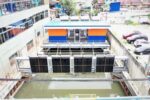Navy’s littoral combat capability gets boost with ex-US patrol vessels

BOOSTING THE FLEET. The BRP Valentin Diaz (PS-177) (left) and BRP Ladislao Diwa (PS-178), formerly US Cyclone patrol vessels, are docked at the Philippine Navy headquarters at Naval Station Jose Andrada, Roxas Boulevard, Manila on Monday (Sept. 11, 2023). Defense Secretary Gilberto Teodoro Jr. said the two ships will greatly enhance the Navy’s littoral capabilities. (PNA photo by Priam Nepomuceno)
MANILA – The commissioning of two former United States (US) Navy Cyclone-class patrol vessels would greatly enhance the capability of the Philippine Navy (PN) to conduct littoral and coastal patrol capabilities.
Speaking at the christening and commissioning rites for BRP Valentin Diaz (PS-177) and the BRP Ladislao Diwa (PS-178) at the Naval Station Jose Andrada, Roxas Boulevard, Manila, Defense Secretary Gilberto Teodoro Jr. said the two Alvarez-class patrol ships are welcome additions to the PN’s littoral fleet in order to “pursue a more robust position in defending our sovereign rights in the 200-nautical mile exclusive economic zone and other jurisdiction of the Republic of the Philippines.”
Littoral refers to the areas near shores or a coastal region.
“This is a task I have given to (Armed Forces of the Philippines) General Headquarters, aligned with past pronouncements that we have to revision and rehorizon our strategic thoughts from strategic principles, defense planning guidance to our modernization to our strategic basing in order for us to be more responsive to the challenges of the times,” Teodoro said.
The DND chief said the Philippines is thankful for the continuing cooperation and collaboration with the United States as its treaty partner.
“And in this we are grateful for the support of the United States and all our allies and like-minded nations because the paradigm here is not for anything else but to preserve a rules-based international order, to preserve the primacy of international law in setting maritime boundaries and in settling disputes,” he added.
Meanwhile, PN chief Vice Admiral Toribio Adaci Jr. said the two ships represent the “commitment of the United States to help enhance our capabilities for maritime operations.”
He said the Alvarez-class patrol vessels are formidable assets in the PN’s maritime arsenal due to their “speed and reliability” which can allow the Navy to swiftly respond to emergencies in “littoral battle spaces, particularly (in) low-intensity conflict environment.”
“As the newest additions to our fleet, they will enhance the Navy’s capacity to defend our maritime nation’s interest and bolster our adaptability addressing various security challenges, from piracy and illicit activities to disaster response and maritime law enforcement. These patrol vessels are essential in maintaining a safe and secure maritime environment,” Adaci noted.
In honor of PH revolutionary heroes
PN spokesperson Capt. Benjo Negranza said the ships are named after Filipino patriots who were among the founders of the Katipunan, which launched the Philippine revolution against Spain in 1896.
The first ship of the class, the BRP General Mariano Alvarez (PS-38), was the former USS Cyclone (PC-1), acquired and activated by the PN in 2004.
“It can maneuver efficiently in coastal and shallow waters where larger vessels could struggle due to its small size and shallow draft. It is suited for patrol operations, interdiction, and surveillance against hostile surface craft. It is a fast and reliable platform that can respond to emergency requirements in a littoral battle space within a low-intensity conflict environment,” Negranza said.
The US Navy transferred these two Cyclone-class patrol vessels upon decommissioning in Bahrain this March 28 through its Excess Defense Article program.
These two former US patrol vessels were stationed at Manama, Bahrain at the time of their decommissioning. They were delivered to the country last May.
Negranza earlier said these 55-meter vessels will be able to complement the PN’s patrol gunboats in ensuring safety and security within the “littoral waters of the porous borders and vast maritime environment of the Philippines, being equipped with the firepower and lethality for littoral operations.”
They are projected to undertake coastal patrols along the country’s littoral waters and sea lanes of communications, maritime interdiction, escort, surveillance and special operations, as well as humanitarian assistance and disaster response missions.
The Cyclones are a class of US Navy coastal patrol vessels consisting of some 14 ships and were constructed from 1992 to 1994.
The vessels weigh around 328.5 long tons and have a length of 179 feet, a beam of 25 feet, and a draft of 7.5 feet.
Their maximum speed is placed at 32 to 35 knots and they have a range of between 2,000 to 2,500 nautical miles. Cyclone-class patrol vessels are armed with 25mm auto-cannons and several high-powered machine guns.
Strategic value to PH-US alliance
US Ambassador to Manila Marykay Carlson, who was also present in the christening and commissioning ceremony of the two of the Alvarez-class patrol vessels, said these ships bring “real, strategic benefit” not only to the country but to the alliance of the two nations, and the entire region.
“As the Philippines continues its courageous stand to uphold the international order and defend its rights in the West Philippine Sea, rest assured the United States stands with you in this all-important endeavor,” she added.
Carlson also said that the two former Cyclone-class patrol vessels have a significant history of service at the forefront of operations for the US Navy,
“They patrolled the waters of the Arabian Gulf in support of operations in the Middle East, including Operations Enduring Freedom and Iraqi Freedom.After refurbishment through US funding, they are now ready to join the PN littoral combat fleet as the BRP Valentin Diaz and BRP Ladislao Diwa,” she added.
Carlson also emphasized that these two ships are entering PN service at an important time when the maritime security environment in the Indo-Pacific is increasingly complex.
“From patrolling Philippine waters, to protecting legitimate economic activity and combating illegal fishing, to delivering humanitarian assistance and disaster relief, the missions undertaken by these two vessels will not be easy. I commend the brave sailors who serve aboard them. Their dedicated service and the missions they undertake are central to the shared US-Philippine goal of ensuring a free, open, and prosperous Indo Pacific region. This commissioning is also the latest illustration of our continued collaboration in pursuit of the modernization goals of the Armed Forces of the Philippines,” she added.
Carlson also emphasized that the Philippines is the largest recipient of US military assistance in the Indo-Pacific.
“In the coming days, senior military leaders from the United States and the Philippines will meet here in Manila for the annual Mutual Defense Board and Security Engagement Board meeting to finalize our shared plans for the coming year – setting a course of action through assistance programs, large-scale exercises, and hundreds of smaller exchanges between our two militaries. All these engagements, large and small, help strengthen the US-Philippine Alliance, building trust and enhancing interoperability –providing protection for us all,” she pointed out. (PNA)






